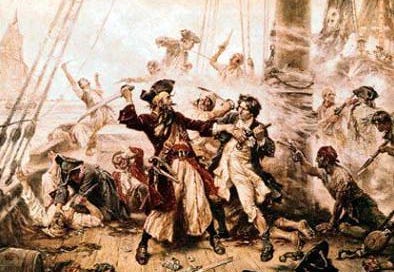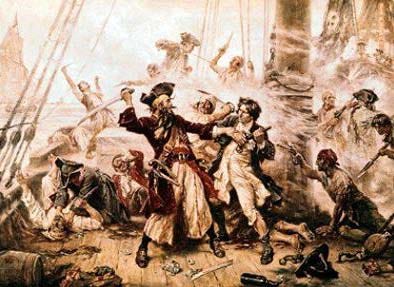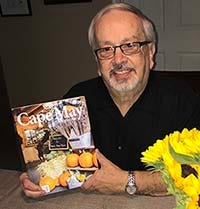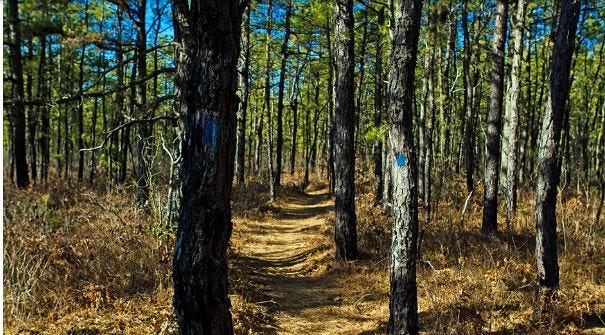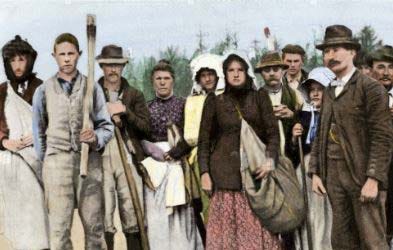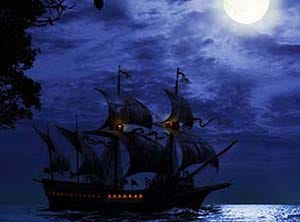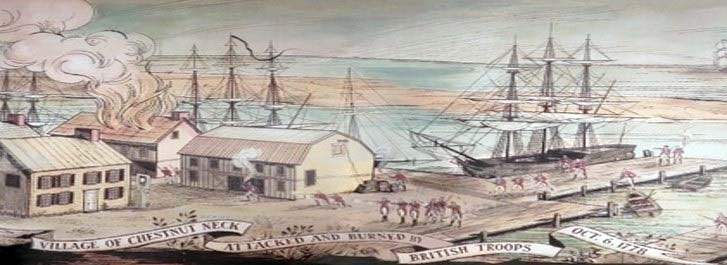Smugglers' Paradise
Innocent looking sandy beaches of South Jersey were big time Pirate havens and made many South Jersey folks very rich.
This is an article I wrote for Cape May Magazine several years ago. The magazine is an outstanding example of what a high end publication should be. Something you don’t see much anymore. Kudos to Kate Chadwick, publisher and her staff. This appeared in the Fall 2017 issue. I have revised it slightly for this post.
Lou with Cape May Mag
HBO's Boardwalk Empire an HBO series that ran in for 5 seasons starting in 2010 had an iconic opening. Bottles of liquor from some unknown smuggler's boat wash ashore on the Atlantic City coastline at the feet of fictitious Prohibition kingpin, Nucky Thompson, played by Steve Buscemi. Although a dramatic opening the scene runs true to the historical Souths Jersey shore.
The isolated sandy shore was a convenient off-loading spot for Prohibition smugglers. But the same South Jersey shore was the location of an enormous trade of smuggled goods estimated in the billions of dollars hundreds of years earlier. Before and during the Revolutionary War, South Jersey's shore and inlets provided alluring drop-off points for smuggled and pirated goods from British and merchant ships bringing cargo to the Colonies.
Many an illicit fortune was made and passed down to now well-respected New Jersey families. The trafficking became so heavy and so infuriating to the British that it eventually led to the only South Jersey Shore skirmish of the Revolutionary War, at Chestnut Creek.
When the Dutch landed in the early 1600s, they named the area Nova Caesara (later renamed New Jersey by the British). They were surprised to find the Eryn Haven's (Egg Harbor) shore littered with thousands of eggs from terns, gulls and other birds lying out in the open.
The Mullica ran for miles from the deep woods almost two- thirds across the state eastward toward this harbor. This sylvan area of pine and oak woods and placid swamps could be a dangerous place, where panthers, wolves, bear, and wildcats roamed. Although most of the indigenous inhabitants were friendly, there were a few hostile Native Americans about.
The Jersey Pine Barrens
The tribes who lived near the shore were generally classified the Unalachtigo, or “People-who-lived-by the sea.” This included the Absegami around Egg Harbor, the Tuckahoes along the river of the same name and the Kechemeches in Cape May. Henry Hudson was the first to encounter the native tribes, in 1609.
In a few decades they were dislocated through use of force and private deeds, usually secured through the normal trinkets and beads transactions to the gullible tribes. Eventually, there were only a few hundred tribesmen remaining, and they ultimately left the area.
South Jersey Pineys
By 1699 pirates and smugglers began to inhabit the easily accessible shore all along the coast from Long Beach Island to Cape May. And by that time the woods were inhabited by the predecessors of the "Pineys,” called "Swamp Angels," or “Swamp Men."
They were a tough breed of squatters who made their living by iron making, charcoal and turpentine manufacturing and, of course, smuggling. In short order, smuggling became one of the primary uses for the land, and an enormous amount of goods landed on the beaches and traversed across the state in heavy wooden wagons over the sandy roads to Haddonfield, Burlington, Cherry Hill, and Philadelphia.
South Jersey was particularly enticing for privateers and smugglers, since the ships carrying cargo could easily be diverted into the harbors behind the shallow inlets, which were also a great refuge from the pursuing British Man-O-Wars that couldn't follow them into the shallow waters.
The “Old Inlet” on Long Beach Island in Ocean County was an excellent entry point into either Little Egg Harboror Chestnut Neck. In what became Cape May County, the Tuckahoe River and Great Egg Harbor provided entrance, and in Atlantic County, Chestnut Neck at the mouth of the Mullica River be- came a major entry point and major annoyance to the British.
Vessels and contents were usually sold at public auction and the proceeds divided among the privateers. Booty included molasses, sugar, coffee, cocoa, salt, cotton, whale oil and whatever items could be stolen or purchased cheaply in the Caribbean and sold for a big profit.
The “Old Inlet” on Long Beach Island in Ocean County was an excellent entry point
Smuggling wasn't the taboo it is today. It was a crime, but largely unenforced since England didn't pursue strict enforcement, given that the British themselves came from a history of piracy and privateering.
Although there were laws against smuggling, they came to be regarded as idle law and became a profit-making venture for many prominent people in America. John Hancock, one of the signers of the Declaration of Independence, was a major trafficker of goods from the French, Dutch, and Spanish West Indies.
Corruption was easy since British customs officials earned a modest salary from the Crown, so bribe money from colonial shippers came in very handy. When smugglers were caught, they were often freed by sympathetic American juries.
Once England abandoned its tolerance of smuggling and began strict enforcement of anti-smuggling efforts, one could say it was one of the causes of the American Revolution, and New Jersey was smack dab in the middle of it. The state became a major hub for smugglers once the Navigation Act of 1651 was enforced to collect taxes on the goods that came in and out of the Colonies.
The Act restricted what the colonies could manufacture, whose ships they could use, and most importantly, with whom they could trade. British merchants wanted a monopoly on what American colonists could buy, which prevented colonists from dealing in Spanish, Dutch or any other European or Caribbean products. In theory, Americans would pay duties on imported goods to discourage this practice. Smuggling was the way to get around the severe restrictions on colonial trade.
In actuality, most of the Acts of Trade and Navigation were obeyed, until the Molasses Act of 1733 broke the camel’s back and ignited a furor from the Colonists. The English Parliament enacted a tax of six pence per gallon on imports of molasses from non-English colonies.
Molasses was the major raw ingredient for the most popular drink at the time, rum, and it became the most popular item smuggled in from Caribbean countries such as Jamaica and Barbados, where it could be purchased cheaply. And one knows, you don't mess with a man's liquor.
Later, in 1764, the strict enforcement of the new Sugar Act became another source of irritation and resentment for Colonial merchants. This resentment led to the famous phrase, “No taxation without representation” and pushed the Colonies into the American Revolution.
CHESTNUT CREEK
Village of Chestnut Hill 1770s
These flagrant acts of smuggling led to the American Revolution's Battle of Chestnut Neck, or Creek, which was fought on October 6, 1778.
The battle took place at a settlement which was used as a base by privateers on the Little Egg Harbor River (now the Mullica River) near the present-day city of Port Republic. Dozens of ships full of materials bound for the British troops in New York City were raided by the soon-to-be Americans and sent down to Little Egg Harbor, their cargoes auctioned off at Richard Westcoat’s tavern at the Forks, or Payne’s Tavern in Chestnut Neck.
American privateers took over the harbor facilities to use as a home base. They would attack and seize British ships and take their captured prizes into Chestnut Neck, where as many as 30 seized ships were moored offloading and selling captured goods, and then sailing back out.
According to Ben Russet, in his book, The Battle of Chestnut Neck: “In August of 1778 alone thirty ships and their cargo were sold. The most notable capture was the Venus of London by privateers from the Chance and the Sly. The cargo consisted of fine broadcloth, linens, calicoes, chintzes, silks, satins, silk and thread stockings, shoes, medicines, books, hardware, butter, cheese, beef, pork, and porter. The ship itself sold for over £16000. It is believed that this capture was the ‘final straw’ that pushed the British to act decisively.”
With the British holding Philadelphia and New York during the winter of 1777-78, General Washington at Valley Forge had been cut off from his supplies. He relied on the smuggled goods being brought into Little Egg Harbor, unloaded at Chestnut Neck, taken up the river on flat boats to the Forks, transported across the state to Burlington, and on to Valley Forge. Little Egg Harbor and Chestnut Neck were a godsend during the most critical period of the War.
With this constant loss of ships and goods, the furious British decided to clean out the nest of rebel pirates in Chestnut Neck. In an attack on the port they retrieved some supplies and destroyed others, but the British and American Loyalists were not able to capture any of the American privateers or recapture any of the prize vessels in the area.
Count Pulaski
Having received intelligence that the formidable Count Pulaski was on his way, the British quickly retreated, stopping at the mouth of the Bass River to destroy the salt works and mills owned by Eli Mathis. They also burned the houses and barns on his plantation, and then rejoined their ships. Later that day the British staged a sneak attack on Pulaski's troops, bayoneting the sentry and almost all of the other 50 of the rebels while they slept, then sailed back to New York. This became known as the “Massacre at Chestnut Creek" whose site is marked by a monument erected by the Sons of Cincinnati.
As we drive today on NJ Routes 40, 30, and 322, we are probably traveling routes initially established by our smuggling forefathers as they traveled on their precarious midnight runs through the forest and swamps with carts of contraband, no doubt dreaming of the great fortunes that were to be made in this smuggler's paradise.


